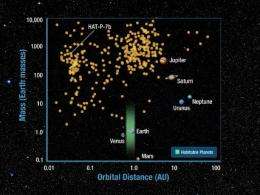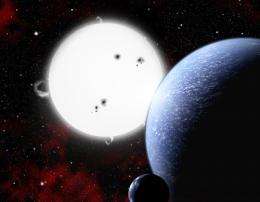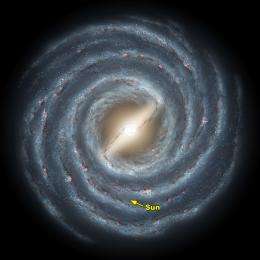Odds for Life Better in Photosynthesis Zones

By calculating where photosynthesis might be possible around the galaxy, scientists are developing a new way to figure out where Earth-like planets with life might be located.
When seeking to figure out where life might evolve, researchers have often focused on the "habitable zones" around stars, where the heat from the star is at the perfect level for liquid water to exist on the surface of a planet in that zone. The reasoning there is that wherever there is water on Earth, there is a chance for life.
Another strategy that physicist Werner von Bloh at the Potsdam Institute for Climate Impact Research in Germany and his colleagues suggest is to focus on the zones around stars where photosynthesis might be possible, since nearly all life on Earth depends on it one way or another for energy.
Although primitive life can exist without photosynthesis, the researchers argue it would be necessary for more complex multi-cellular organisms to emerge. This is because the main source for oxygen on Earth comes from photosynthetic life, and oxygen is thought to be necessary for multi-cellular life to arise.
To find such "photosynthesis-sustaining habitable zones" around stars, the researchers explain one should concentrate on where the global average surface temperature of a world in the zone stays between the freezing and boiling points of water (0 to 100 degrees Celsius).
They also say to look for planets where there are sufficient levels of carbon dioxide in the atmosphere, which photosynthetic life would consume to make oxygen and create organic matter. They assume these planets experience plate tectonics to help replenish vital supplies of key minerals.

Stars of a Certain Size
When analyzing worlds for their photosynthetic sustainability, looking at their stars is key. Stars grow in luminosity as they age, destroying some photosynthesis-sustaining habitable zones while potentially creating others.
For instance, after small- and mid-sized stars consume all their hydrogen fuel, they become red giants, increasing 1,000 to 10,000 times in luminosity. This would be too much heat for any life that developed in their original photosynthesis-sustaining habitable zones, but could result in a new such zone for planets farther away. This new, more distant habitable zone could last up to 1 billion years, until these red giants sputtered out to become white dwarfs.
Using this logic, the researchers suggest there is no point considering stars larger than 2.2 solar masses since they would become red giants in less than 800 million years. Larger stars evolve more quickly, and life might need more time to emerge. Still, other scientists have suggested life could develop in as little as 500 million years, which means stars smaller than 2.6 solar masses might do.
Spotting Suitable Worlds
Given these limitations, von Bloh and his colleagues estimated our galaxy might host up to 2.5 million worlds suitable for complex multi-cellular photosynthetic life. Moreover, they calculated that up to 690 million worlds could host more basic single-celled life that could also be photosynthetic, similar to cyanobacteria on Earth. They detailed their findings in the June issue of the journal Plant Science.

The researchers note their calculations as to the prevalence of complex life might get narrowed down even further if other factors are considered. For instance, large moons around planets in these zones might help the planets stabilize their tilt, leading to a stable climate. In addition, the presence of giant worlds elsewhere in these systems could help shield habitable planets from cosmic impacts.
On the other hand, their assumptions might be a bit conservative. For example, the researchers focused just on roughly Earth-sized planets.
"Doing the simulations with planetary masses ranging from 0.1 with 10 Earth masses might be interesting," von Bloh noted. Moreover, "defining habitability based on carbon-based photosynthesis-performing life forms might be too Earth-centric. There might exist other life forms different from Earth life."
In any case, it could be a while before scientists can endeavor to look for signs of photosynthesis on alien worlds. Although the NASA Terrestrial Planet Finder and ESA Darwin missions would have aimed to look for oxygen or ozone as hints of photosynthetic life, Terrestrial Planet Finder has been indefinitely postponed, and studies have ended for Darwin.
"Finding signs of life on other planets might be the most challenging goal in astrobiology," von Bloh said.
Source: Astrobio.net




















